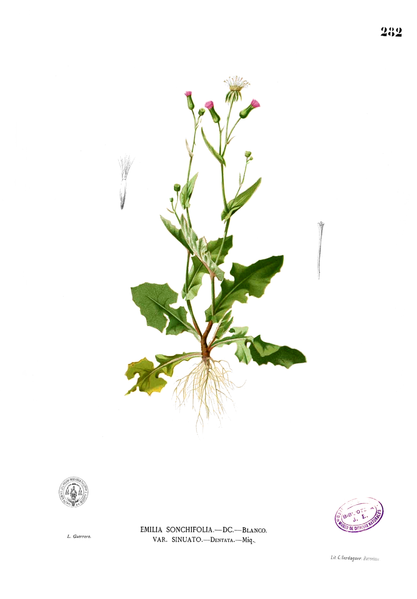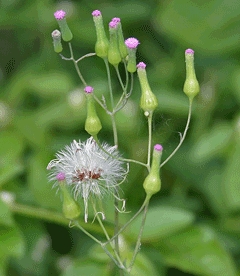 |
|
http://commons.wikimedia.org/wiki/File:Emilia_sonchifolia_Blanco2.282.png |
 |
| http://commons.wikimedia.org/wiki/User:J.M.Garg |
Translate this page:
Summary
Physical Characteristics

 Emilia sonchifolia is a ANNUAL growing to 0.6 m (2ft).
Emilia sonchifolia is a ANNUAL growing to 0.6 m (2ft).
See above for USDA hardiness. It is hardy to UK zone 9 and is frost tender. It is in flower from July to October, and the seeds ripen from August to October. The species is hermaphrodite (has both male and female organs) and is pollinated by Insects. The plant is self-fertile.
Suitable for: light (sandy), medium (loamy) and heavy (clay) soils and prefers well-drained soil. Suitable pH: mildly acid, neutral and basic (mildly alkaline) soils. It cannot grow in the shade. It prefers moist soil.
UK Hardiness Map
US Hardiness Map
Synonyms
Cacalia sonchifolia.
Plant Habitats
Cultivated Beds;
Edible Uses
Edible Parts: Leaves Shoots
Edible Uses:
Leaves and young shoots - raw or cooked[2, 46, 61, 105, 177, 272]. Used as a vegetable[272]. The whole plant, including the flowers, can be eaten raw or cooked[144]. The leaves are usually harvested and used before the plant flowers[183]. A nutritional analysis of the leaves is available[218]. The powdered plant is used to prepare a cake fermented with yeast (called marcha in Nepal) from which liquor is distilled[272].
References More on Edible Uses
| Composition
|
| Figures in grams (g) or miligrams (mg) per 100g of food.
|
|
|
Leaves (Dry weight)
|
|
- 308 Calories per 100g
- Water : 0%
- Protein: 22g; Fat: 3.3g; Carbohydrate: 64.3g; Fibre: 11g; Ash: 10.4g;
- Minerals - Calcium: 2187mg; Phosphorus: 648mg; Iron: 0mg; Magnesium: 0mg; Sodium: 0mg; Potassium: 0mg; Zinc: 0mg;
- Vitamins - A: 0mg; Thiamine (B1): 0mg; Riboflavin (B2): 0mg; Niacin: 0mg; B6: 0mg; C: 0mg;
- Reference: [ ]
- Notes:
|
|
Medicinal Uses
Plants For A Future can not take any responsibility for any adverse effects from the use of plants. Always seek advice from a professional before using a plant medicinally.
Astringent Depurative Diaphoretic Diuretic Dysentery Expectorant Febrifuge Odontalgic
Ophthalmic
A tea made from the leaves is used in the treatment of dysentery[218]. The juice of the leaves is used in treating eye inflammations, night blindness, cuts and wounds and sore ears[240, 272]. The plant is astringent, depurative, diuretic, expectorant, febrifuge and sudorific[147, 218, 272]. It is used in the treatment of infantile tympanites and bowel complaints[240]. The juice of the root is used in the treatment of diarrhoea[240, 272]. The flower heads are chewed and kept in the mouth for about 10 minutes to protect teeth from decay[272].
References More on Medicinal Uses
The Bookshop: Edible Plant Books
Our Latest books on Perennial Plants For Food Forests and Permaculture Gardens in paperback or digital formats.

Edible Tropical Plants
Food Forest Plants for Hotter Conditions: 250+ Plants For Tropical Food Forests & Permaculture Gardens.
More

Edible Temperate Plants
Plants for Your Food Forest: 500 Plants for Temperate Food Forests & Permaculture Gardens.
More

More Books
PFAF have eight books available in paperback and digital formats. Browse the shop for more information.
Shop Now
Other Uses
References More on Other Uses
Cultivation details
An easily grown plant[1], succeeding in most well-drained soils in a sunny position[200]. Plants flower better when growing on nutritionally poor soils, producing much lusher growth on rich soils[200]. Plants are drought tolerant once established[200]. Plants are not frost hardy, but they succeed outdoors in Britain as a spring-sown annual[200]. Slugs can be a problem with this plant in a wet spring[200]. The leaves are frequently sold in local markets in Java[183].
References Carbon Farming Information and Carbon Sequestration Information
Temperature Converter
Type a value in the Celsius field to convert the value to Fahrenheit:
Fahrenheit:
The PFAF Bookshop
Plants For A Future have a number of books available in paperback and digital form. Book titles include Edible Plants, Edible Perennials, Edible Trees,Edible Shrubs, Woodland Gardening, and Temperate Food Forest Plants. Our new book is Food Forest Plants For Hotter Conditions (Tropical and Sub-Tropical).
Shop Now
Plant Propagation
Seed - sow early spring in a greenhouse and only just cover the seed. When large enough to handle, prick the seedlings out into individual pots and plant them out after the last expected frosts[1, 200]. The seed can also be sown outdoors in situ in the middle of spring[1, 200].
Other Names
If available other names are mentioned here
Native Range
TEMPERATE ASIA: China (Anhui Sheng, Fujian Sheng, Guangdong Sheng, Guizhou Sheng, Hainan Sheng, Hebei Sheng, Henan Sheng, Hubei Sheng, Hunan Sheng, Jiangsu Sheng, Shaanxi Sheng, Sichuan Sheng, Yunnan Sheng, Zhejiang Sheng), Japan (Honshu, Kyushu, Ryukyu Islands, Shikoku), Taiwan TROPICAL ASIA: Bhutan, India, Sri Lanka, Nepal, Papua New Guinea, Thailand, Vietnam, Indonesia, Malaysia, Philippines
Weed Potential
Right plant wrong place. We are currently updating this section.
Please note that a plant may be invasive in one area but may not in your area so it's worth checking.
Conservation Status
IUCN Red List of Threatened Plants Status :

Growth: S = slow M = medium F = fast. Soil: L = light (sandy) M = medium H = heavy (clay). pH: A = acid N = neutral B = basic (alkaline). Shade: F = full shade S = semi-shade N = no shade. Moisture: D = dry M = Moist We = wet Wa = water.
Now available:
Food Forest Plants for Mediterranean Conditions
350+ Perennial Plants For Mediterranean and Drier Food Forests and Permaculture Gardens.
[Paperback and eBook]
This is the third in Plants For A Future's series of plant guides for food forests tailored to
specific climate zones. Following volumes on temperate and tropical ecosystems, this book focuses
on species suited to Mediterranean conditions—regions with hot, dry summers and cool, wet winters,
often facing the added challenge of climate change.
Read More
Expert comment
Author
(L.)DC.
Botanical References
58200
Links / References
For a list of references used on this page please go here
Readers comment